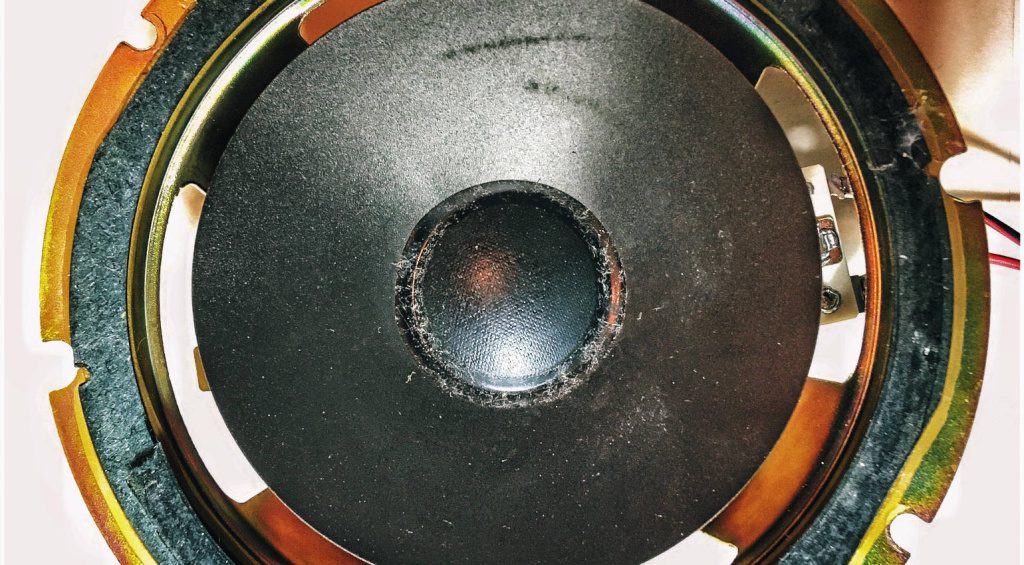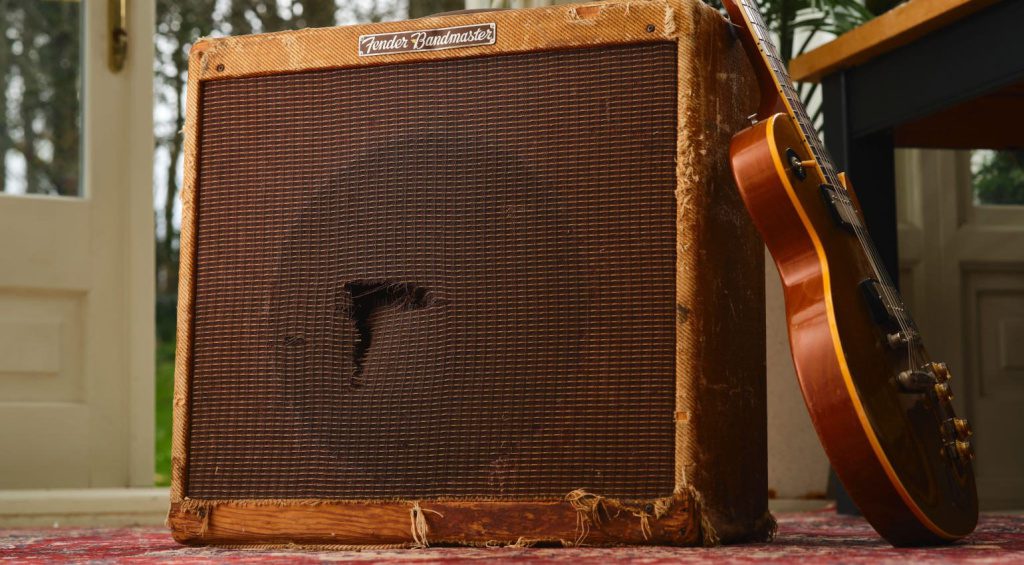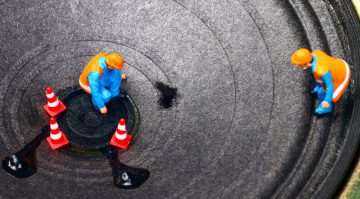We spend a pretty penny on tube amps, guitars, pickups, and effects. Cables can easily cost 100 bucks or more. But what about the part of the signal chain that actually broadcasts the sound? Guitar speakers are the unsung heroes of our gear and deserve more attention.
What’s the matter with guitar speakers?
No matter how good your guitar equipment is, it’s all more or less useless if there’s no guitar speaker connected to the end of your signal chain. Whether it’s a classic speaker in a combo or box, an FRFR system, hi-fi speakers, or even studio monitors, without these sonic emitters, we’re stuck with acoustics.
Oddly, guitar cabs don’t seem to have the same appeal as effects and amps do for many. If you take a look at the relevant guitar forums, you’ll see there aren’t many posts about guitar speakers. This could be because the technical details are a little more complex.
However, I think it’s a bit more superficial than that. If you could actually see the speakers in their fancy cabinets on stage openly, they would be the stars of the show. I’m thinking of hand-painted graphics, colorfully anodized screws, and so on. If guitar speakers were more visible, more would be said about them. Let’s change that!
Technical basics: How guitar speakers shape your sound
If you want to know why guitar cabs have such a significant impact on the sound of your guitar, it’s worth taking a closer look at the technical basics. Of course, you don’t have to study physics to do so.
Loudspeakers are devices that turn electrical signals into sound waves. They’re made of a membrane that moves when an electric current flows through it. A voice coil drives this movement in a magnetic field. There are quite a few components that affect the sound of guitar speakers. In the next section, we’ll look at these from both the inside and the outside.
Diaphragms, magnets, and more – guitar speakers’ inner workings
What materials are used for the diaphragm? The material the diaphragm is made of significantly impacts the sound quality and frequency range of a guitar cab. While Kevlar or fiberglass are often used in hi-fi or bass speakers, paper diaphragms are still the go-to choice for guitar speakers. This much more organic material naturally damps the signal a bit because of its physical limitations. Paper diaphragms also produce a warm, resonant sound with rich mids. And that’s where guitars feel most “at home” – sonically speaking.

Then, there are a few different types of magnets: each type impacts the dynamics and basic character of the speaker differently. Alnico magnets (Alnico stands for aluminum-nickel-cobalt) are known for their soft, compressed sound and are typically associated with vintage amplifiers, like the Celestion Alnico Blue*. Ceramic magnets are also quite common for guitar cabs. They’re usually cheaper and offer a more direct sound with higher levels, which is great for those who enjoy playing at high volumes and with heavily distorted sounds. A classic example here would be the Celestion G12M-65 Creamback.*
Furthermore, both the material of the voice coil and of the cone matter. The voice coil is responsible for converting electrical signals into mechanical movements. Voice coils vary in their winding density and material composition, which (theoretically) affects the speaker’s efficiency and thermal load capacity. The cone, which holds the membrane and the voice coil itself, can either be open or closed. Some say an open design sounds much more three-dimensional, while a closed cabinet better amplifies the bass range.
Every loudspeaker has a specific frequency response curve that describes how well it reproduces different frequencies (i.e., treble, mid-range, and bass). Guitar speakers are often tuned to emphasize the mid-range and attenuate the extreme treble and bass frequencies. The resonance frequency of a speaker is the frequency at which the membrane vibrates the most.
External values: From open and closed cabinets
The design of a guitar speaker’s cabinet is critical for how the sound is formed: open cabinets (open-back) direct sound in both directions. Here, the sound is more spread out and less bass-heavy.
Closed cabinets (closed-back) stop sound from emitting in both directions and produce a tighter, more focused sound. You can even set them against the wall in your rehearsal room without immediately causing bass issues.
Ported cabinets are a special breed of guitar cabs. They have openings or ports in their housing. Ported cabinets combine the properties of open and closed cabinets and offer extended bass reproduction and more volume.
It doesn’t matter if you’re talking about inner or outer values: these technical intricacies of guitar speakers show that selecting a guitar speaker is not just about making sure it works with your amp. These components and their varying sonic characteristics also have a significant impact on the overall sound of your setup.
The interaction between Amp and Cab
The way the amp and cab interact affects the sound quite dramatically, whether it’s a guitar amp or a hi-fi system. Tube amps are known for their warm and dynamic sound, and they work really well with speakers that use softer membranes and Alnico magnets. These better emphasize harmonics and natural compression. Transistor amplifiers are usually considered clear and precise sounding, and they work well with speakers with harder membranes and ceramic magnets.

As always, this is supposed to be a rough guide and isn’t necessarily correct in all areas. I personally used a Laney tube amp with the aforementioned Celestion G12M-65 Creambacks for quite some time and liked the outcome quite a bit.
Sonic characteristics and application
The speakers you use can impact the sound of your guitar quite a bit. Vintage speakers like the Celestion Greenback are known for their warm, mid-range sound, which is great for classic rock and blues tones. “Clearer” speakers like the Celestion V30 offer a brighter, more precise reproduction that is well-suited for metal and other aggressive music styles.
The bottom line is that some speakers are better suited to certain genres. If you’re looking for a speaker for blues, rock, or similar genres, you’ll want one with emphasized mids and a softer character. For metal or even jazz, you’ll want a speaker with a clear, detailed reproduction and an appealing volume response.
Buyer’s advice (sort of)
As you can see, picking the right guitar speaker is critical to getting the sound you want. To save you from having to read a more extended guide later on, here are the most important things to think about when choosing your setup:
Diaphragm material:
Paper, Kevlar, and fiberglass have different sonic characteristics. Paper produces warm and resonant tones, while Kevlar and fiberglass provide a more precise and brighter reproduction and are usually used in hi-fi and FRFR systems. The classic and recommended material for guitar speakers is, therefore, paper – feel free to experiment with other materials!
Magnet type:
Alnico magnets give you a softer, compressed tone, perfect for vintage sounds. Ceramic magnets offer a harder, more direct sound with a higher output level, which is ideal for modern music styles.
Sensitivity:
Guitar speakers with high sensitivity (measured in dB/W/m) can achieve higher volumes with less amplifier power, which can be really useful in live situations. On the other hand, lower sensitivities can help during recording or direct pickup.
Cabinet design:
Open-back cabinets give a nice, open sound, while closed-back cabinets are more focused and have stronger bass. Ported cabinets combine the best of both and have great bass response and volume.
Value for money:
It’s not true that you have to spend a lot of money to get a good speaker. Lots of manufacturers make models that sound great and don’t an arm and a leg. We’ve also seen that brands like Celestion, Eminence, and Jensen have a lot to offer, with models for different budgets and sonic preferences.
Conclusion
It’s easy to forget how essential guitar speakers are in the setup, even though they have a significant impact on the overall sound. While effect pedals and amplifiers often grab our attention, choosing the right speaker can make a big difference in the sound character.
There are lots of technical details to consider, like the diaphragm material, magnet type, sensitivity, and cabinet design. These all play a role in shaping the sound and finding a speaker that’s right for you.
More on guitar cabs
Originally published at Gearnews.de by Jan Rotring, translation by Julian Schmauch.
*This post contains affiliate links and/or widgets. When you buy a product via our affiliate partner, we receive a small commission that helps support what we do. Don’t worry, you pay the same price. Thanks for your support!






